 |
| Cosmos sulphureus, a short-lived annual native to the American tropics, is attractive to many insects. |
UPDATE: The United States Department of Agriculture Plants Database lists the scientific name of the common garden zinnia as
Zinnia violacea; however, the Atlas of Florida Vascular Plants uses the name
Zinnia elegans and lists
Zinnia violacea as a
nomen rejiciendum (a rejected name) under the rules of the International Code of Nomenclature for Algae, Fungi, and Plants. As a result, the name
Zinnia elegans is used in this blog post.
I visited the garden of Robert Hopper today and found that his cottage garden annuals were in full bloom. Further north, these annuals would be planted in the spring to flower in the summer. Here in south Florida, they are planted in the autumn to flower throughout the winter.
Some of the plants in flower included
Cosmos bipinnatus, Cosmos sulphureus, Portulaca grandiflora, Salvia farinacea, Zinnia angustifolia, and
Zinnia elegans. Except for
Salvia farinacea, which is a perennial native to Texas and New Mexico, these plants are all annuals native to Central or South America. To date, none have exhibited invasive tendencies in the United States and all have showy flowers that are attractive to numerous native pollinating insects as well as to honeybees. The plants of
Zinnia elegans apparently came from
open-pollinated seeds Burpee's Cut & Come Again Mix and a wide variety of colors and forms, including singles, semi-doubles, and doubles, were present in the garden. Fully double zinnias have little or no wildlife value but zinnias with single and semi-double flowers are irresistible to honeybees, native bees, hover flies, skippers, butterflies, hawk moths, various flower-visiting wasps, and
hummingbirds.
Zinnia elegans, the common garden zinnia, tends to be short-lived in south Florida and is subject to diseases and pests that disfigure the leaves such as viruses, downy mildew, and leaf miners. It was originally native to Mexico but can now be found in gardens nearly throughout the world. If allowed to go to seed, it can persist in garden settings from self-sown seedlings but it eventually reverts to its wild form and plants with double, pom-pom-like flowers are replaced by plants with single or semi-double flowers. It also tends to escape from cultivation, especially to roadsides and other areas kept free from competing vegetation by natural disturbances or human activity; however, it generally does not persist for long.
Below are images of a few of the plants in Rob's garden as well as a rather extensive gallery of some of the many variations of Zinnia elegans that sprung up in his garden.
 |
| Angelonia angusifolia soon dies in my garden but this attractive dark purple form has proven to be long-lived in Rob's garden. Originally native to Mexico and Guatemala, it is now widespread in the tropics as an escape from cultivation. |
 |
| Landoltia punctata has formed a solid cover on the surface of a small aquatic garden in Rob's yard. It is frequently misidentified as a native duckweed; however, no North American records are known prior to its occurrence in 1930 in a goldfish pond in Kansas City, Missouri, and it is now known to be native to southeast Asia and Australia. |
 |
| Zinnia angustifolia is a small annual that produces numerous brilliant white, yellow, or orange daisies. It does not last long in the garden since it tends to quickly flower and seed itself to death. Native to Mexico, it has been bred with Zinnia elegans to produce a hybrid zinnia that has the disease resistance and abundant flowers of the former with the large flower size and range of colors of the latter. |
All subsequent images are of the various forms of Zinnia elegans that sprung up in Rob's garden.
 |
| Zinnia elegans with flowers of an unusual burnt orange color. In the upper right, one can see the attractive flower buds typically found in garden zinnias. These are globose and have green bracts with black-rimmed margins. |
 |
| Plants of Zinnia elegans with single flowers, such as this one, have the most wildlife value since the yellow disc florets provide plenty of pollen and nectar. |
 |
| A plant of Zinnia elegans with semi-double flowers. |
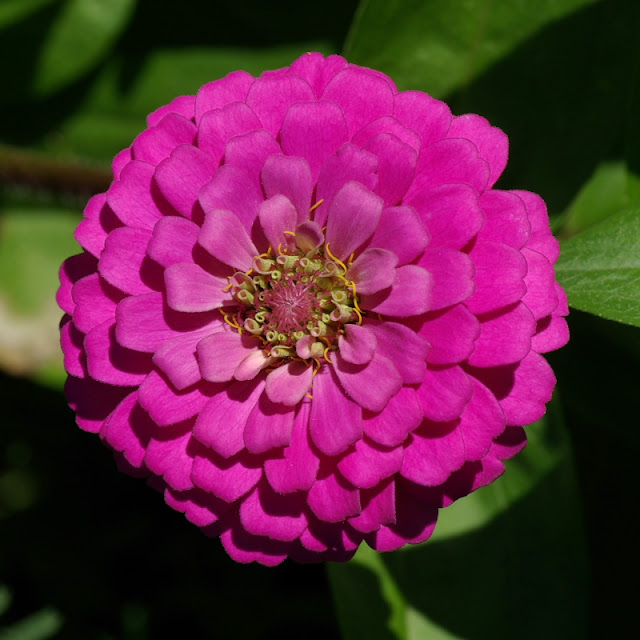 |
| Plants of Zinnia elegans with fully double flowers, such as this one, lack the pollen- and nectar-bearing disk florets and have little value to insect wildlife. |
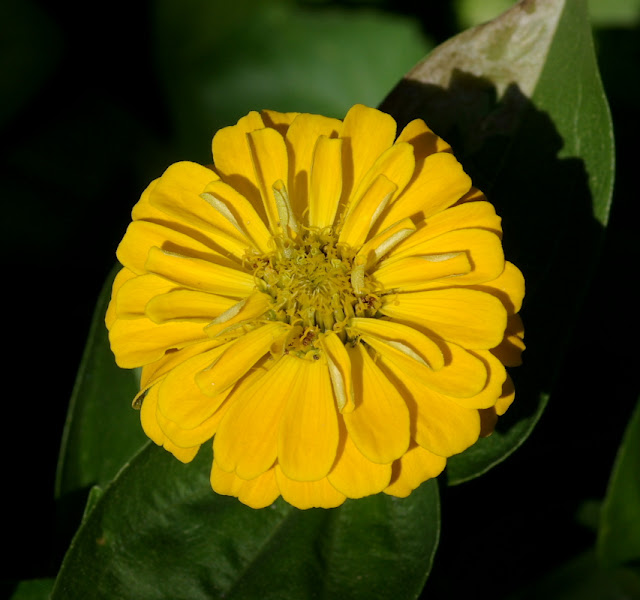 |
| The discoloration of the leaf in the upper right hand corner of the photograph is the result of leaf miners. |
 |
| The flower heads in this photograph and the following two photographs are displaying symptoms caused by the Bidens mottle virus, which causes deformities of the leaves as well as color breaks in the flowers. |
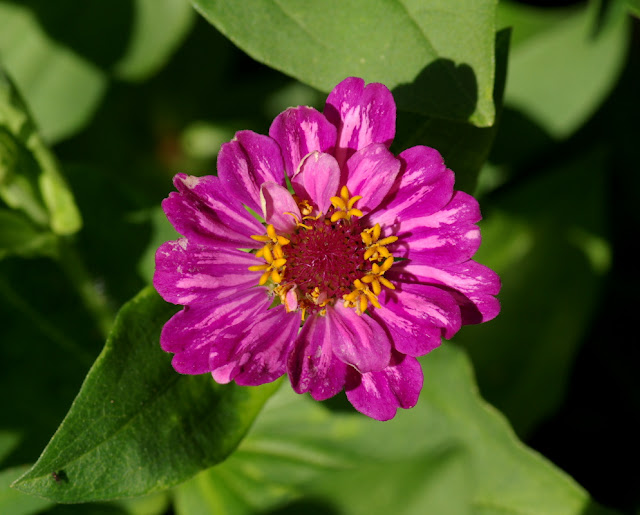 |
| Color breaks, such as those shown in this photograph, are a symptom of the Bidens mottle virus. The virus is spread by aphids and is hard to avoid since Bidens alba, a common and abundant weed of south Florida, serves as a reservoir by which the virus can readily infect garden plants. |
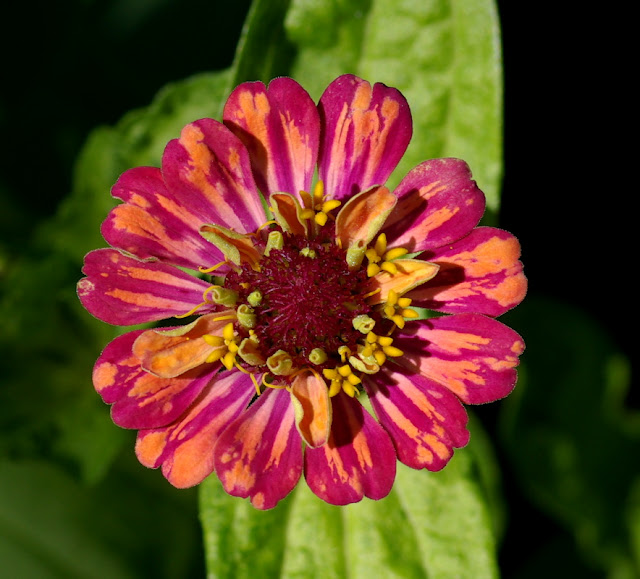 |
| The effects of Bidens mottle virus are sometimes dramatic and colorful as in the above example; however, if such plants are not destroyed they will act as a reservoir for the virus and allow the virus to spread to other plants. |
 |
| A honey bee, Apis mellifera, on Zinnia elegans. The foliage in the background, as well as in the flower buds in the lower left hand corner, belong to Cosmos sulphureus. |
 |
| The spiny branches visible in the photograph belong to Acacia pinetorum, a small, shrubby, native acacia that becomes a mass of fragrant, yellow, globose flower heads in the spring. |

















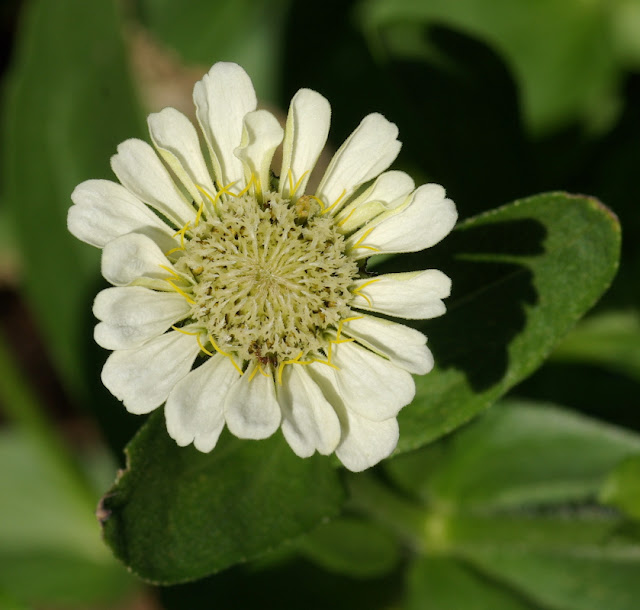




No comments:
Post a Comment